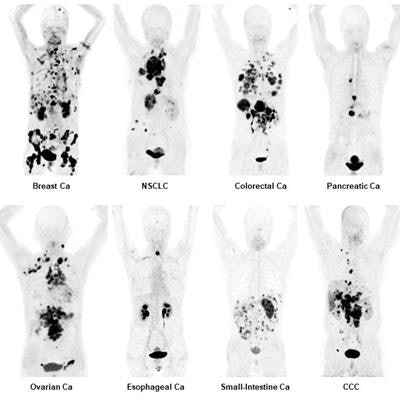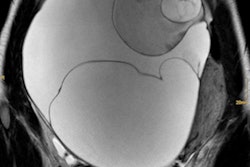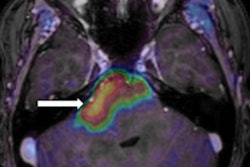
Researchers from Heidelberg, Germany, have won this year's Image of the Year prize at the annual Society of Nuclear Medicine and Molecular Imaging (SNMMI) meeting in Anaheim, California, U.S., for their radiotracer that can detect 28 different types of cancer.
The gallium-68 (Ga-68)-based radiotracer acts as a fibroblast activation protein inhibitor (FAPI), which targets the overexpressed proteins present in cancer. The result is exceptionally clear tumor delineation and high image contrast. The researchers believe that its versatility allows for new applications in noninvasive diagnosis, staging, and treatment for a range of conditions.
"Imaging with new tracers such as the one developed -- and very nicely demonstrated in this study in a wide variety of cancer types -- shows the power of molecular imaging to characterize tumors," said Dr. Umar Mahmood, chair of the SNMMI Scientific Program Committee. "The Image of the Year epitomizes the great progress made in our field in developing new imaging agents to help optimize cancer therapy for individual patients through such noninvasive characterization."
The Ga-68 FAPI radiotracer was featured in the June issue of the Journal of Nuclear Medicine. In that paper, lead author Dr. Clemens Kratochwil from University Hospital Heidelberg and colleagues wrote, "Several epidemiologically important tumor entities, in particular breast, esophagus, lung, pancreatic, head-neck, and colorectal cancer, present with a remarkably high uptake in Ga-68 FAPI PET/CT. This may open new applications for noninvasive tumor characterization and staging examinations."
More specifically, the SNMMI Image of the Year for 2019 demonstrates the uptake of the FAPI in 12 epidemiological tumor entities, including high uptake values in lung, breast, prostate, esophageal, and pancreatic cancer.
 Ga-68 FAPI PET/CT in patients shows 12 different tumor entities. Ca = cancer; NSCLC = non-small cell lung cancer; CUP = carcinoma of unknown primary; CCC = cholangiocarcinoma; GEP-NET= gastroenteropancreatic neuroendocrine tumor. Images courtesy of Kratochwil et al and SNMMI.
Ga-68 FAPI PET/CT in patients shows 12 different tumor entities. Ca = cancer; NSCLC = non-small cell lung cancer; CUP = carcinoma of unknown primary; CCC = cholangiocarcinoma; GEP-NET= gastroenteropancreatic neuroendocrine tumor. Images courtesy of Kratochwil et al and SNMMI.In contrast to FDG-PET/CT, Ga-68 FAPI PET/CT can be performed without specific patient preparation, such as fasting and reclining during uptake time, and the uptake time is very short at approximately 10 minutes. In addition, this research could become a steppingstone to the development of cancer treatments in the future.
"Immunotherapies can be highly effective in some patients and without any antitumor activity in other patients," said Dr. Uwe Haberkorn, professor and chair of nuclear medicine at the University Hospital of Heidelberg, in a statement. "Currently, predictive biomarkers for appropriate patient selection are limited. Due to its biological role, FAP-targeted diagnostics has the potential to be a predictive biomarker."
Ga-68 FAPI PET also could add important diagnostic value to challenging cancer subtypes such as pancreatic, ovarian, and colorectal cancer, which are difficult to assess on FDG-PET. Additionally, it could potentially promote a new way to evaluate patients with chronic inflammatory pathogenesis or myocardial infarction.



















